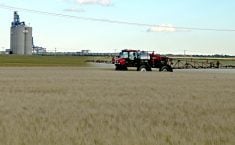Trade and technical experts visit key wheat markets in Asia, Latin America, Europe, Africa and the Middle East
Delegates from Cereals Canada are back on the road, promoting Canada’s quality milling wheat to potential buyers around the world.
After a two-year break prompted by COVID-19, the Winnipeg-based organization resumed its participation in annual new wheat crop trade and technical missions, aimed at promoting the Canadian wheat crop.
All told, four Canadian delegations travelled to a total of 15 countries in December 2022 and January 2023, Cereals Canada said.
The delegations consisted of trade and technical experts from Cereals Canada, along with representatives from the Canadian Grain Commission, Grain Farmers of Ontario, Canadian wheat producers and grain exporters.
Read Also

New coal mine proposal met with old concerns
A smaller version of the previously rejected Grassy Mountain coal mine project in Crowsnest Pass is back on the table, and the Livingstone Landowners Group continues to voice concerns about the environmental risks.
The delegation visited key markets for Canadian wheat in Asia, Latin America, Europe, Africa and the Middle East to share technical information about the 2022 wheat crop with buyers, millers, bakers and processors.
“As we travelled from country to country, what we heard from customers is they are happy with (the 2022) crop,” said Elaine Sopiwnyk, vice-president of technical services at Cereals Canada.
“We had many comments about the large supply, overall quality and good gluten functionality.”
Last year’s durum crop offered high semolina yields, along with good yellowness and processibility, she added.
“People were happy to welcome us back and have the opportunity to ask questions face-to-face,” added Cereals Canada chief executive officer Dean Dias.
“Over the past two years, our team has done an excellent job presenting the information to our customers in an online-only format, but one of our greatest strengths is building relationships. That’s what makes these in-person trade and technical sessions so important.”
Canadian growers harvested a high-quality crop in 2022, with above-average production and higher-than-normal protein content in most regions.
Out of 2,876 Canada Western Red Spring wheat samples assessed from last year’s harvest, nearly 80 percent were graded No. 1 and 13.6 percent were graded No. 2.
Mean protein content across all grades ranged from a low of 13.5 percent in Alberta and British Columbia to a high of 14.3 percent in Manitoba, according to data from the CGC.
Saskatchewan’s mean protein across all grades was 14.1 percent compared to a western Canadian mean of 13.9 percent.
Western composite samples also showed higher test weights compared to 2021 and a significant improvement in the No. 1 CWRS falling number at 423 in 2022, compared to 354 in 2021.
Sopiwnyk said wheat millers and processors around the world typically work with a variety of different wheat quality parameters and protein levels.
Wheats from different countries are often blended to meet preferred end-use characteristics.
Having access to large quantities of milling wheat with consistent protein levels and milling qualities is “important to our customers to meet their end-product requirements,” she said.
Canadian farmers produce sustainable, high quality cereal crops that enhance food security at home and around the globe, added Dias.
“It felt good to return to meeting with customers in-person to communicate this message, along with the excellent quality and functionality of (the 2022) wheat crop,” he said.
Cereals Canada represents all stakeholders in the cereal grains value chain including farmers, exporters and processors.


















